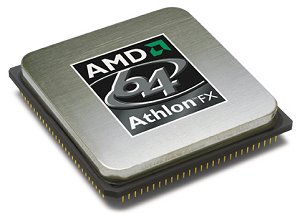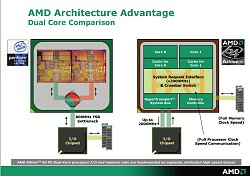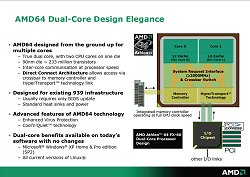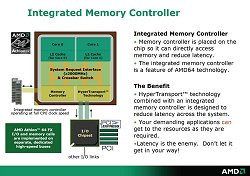Today, AMD is releasing its latest FX based CPU, the FX-60. First off, you may say, “What happened to the odd number scheme FX-51, FX-53, FX-55 and FX-57?” Well, this new CPU starts off 2006 in the AMD world of Dual-Core Performance CPU. At this time, we see that these dual-core CPUs will end with an even number scheme.
Introduction
Today, AMD is releasing its latest FX based CPU, the FX-60. First off, you may say, “What happened to the odd number scheme FX-51, FX-53, FX-55 and FX-57?” Well, this new CPU starts off 2006 in the AMD world of Dual-Core Performance CPU. At this time, we see that these dual-core CPUs will end with an even number scheme.
AMD was quick to point out that this CPU is considered an FX-55 replacement and not targeted as a FX-57 replacement. The CPU’s dual cores run at 2.6GHz, which is the exact same core speed of the FX-55. The FX-57 will still be made but at some point in the future will be replaced with a dual-core CPU. The FX series has long been known as the best gaming CPU on the market, but the FX CPUs would not let you do other tasks in the background as well. This has always been a problem with single core CPUs since most end users will run antivirus, anti-spyware, IM client and firewall software. All of that does eat up CPU cycles and does take performance away from the CPU. With the X2 CPUs, end users have been able to play games and not get hit by the overhead of other applications. With the FX-60, AMD’s goal is to bring the end user the best gaming/desktop CPU on the market.

Specifications
Let’s look at the specifications of the AMD FX-60.
| Frequency / Cache Sizes: | 2.6GHz w/ 1MB L2 cache-per-core (2MB total L2 per processor) |
| L1 Cache Sizes: | Each core has its own 64K of L1 instruction and 64K of L1 data cache (256KB total L1 per processor) |
| CPU to Memory Controller: | Same as CPU core frequencies |
| Memory Controller: | Shared integrated 128-bit wide memory controller |
| Types of Memory: | PC1600, PC2100, PC2700 and PC3200 DDR memory |
| HyperTransport Links: | 1 |
| HyperTransport Spec: | 2GHz (2x 1000MHz / DDR) |
| Effective data bandwidth: | 4.4 GB/sec [8GB/sec x1 HyperTransport link + 6.4GB/sec memory bandwidth] |
| Packaging: | 939-pin organic micro-PGA |
| Fab location: | AMD’s Fab 30 wafer fabrication facility in Dresden, Germany |
| Process Technology: | 90nm (.09-micron) Silicon on Insulator (SOI) |
| Approximate Transistor count: | 233.2 million |
| Approximate Die Size: | 199mm2 |
| Nominal Voltage: | 1.30-1.35V |
| Max Thermal Power: | 110 W |
| Max Ambient Case Temp: | 65 degrees Celsius |
| Max Icc (processor current): | 80A |
| Min P-State (with C’n’Q): | 1.2 GHz |
| Nominal Voltage: | 1.1V |
| Max Thermal Power: | 46.7W |
| Max Icc: | 39.8A |
Test Systems & Benchmarks
AMD Athlon 64 FX Test System
- Asus A8N32-SLI Deluxe
- AMD Athlon 64 FX-60 (and FX-55 for SLI tests)
- 2GB Corsair 3500LL PRO
- 3 x 250GB Maxtor Diamond 10 in RAID 5
- PC Power & Cooling 1kW PSU
- Creative X-Fi Platinum Sound Card
- 2 x Reference 7800 GTX 512
- Windows XP SP2
- ForceWare 81.98 and DirectX 9.0c
Intel Pentium 4/D Test System
- Gigabyte 955X Royal
- Intel Pentium 4 670 (3.8GHz) and Pentium D 840 (3.2GHz dual-core)
- 1GB Corsair 5400UL DDR2
- 74GB Western Digital Raptor
- Enermax PSU
- XFX 7800 GTX 512 XXX (clocked to match reference)
- Windows XP SP2
- ForceWare 81.98 and DirectX 9.0c
We don’t have any dual-core Extreme Edition CPUs for comparison, but here’s how AMD sees its FX-60 as superior over the Pentium Extreme Edition 840. This chart was probably made before the Pentium Extreme Edition 955 was released, but it’s worth noting that the 955 has a front side bus of 1066MHz.
Benchmarks
- Futuremark PCMark05
- SiSoftware Sandra 2005 – CPU Arithmetic, CPU Multimedia and Memory Bandwidth
- Super PI – 32M
- Futuremark 3DMark05
- Counter-Strike: Source
- F.E.A.R.
- Quake 4
Test Results – System
During the testing, the FX-60 test system had 61 processes running while the Intel rig usually had around 25 running. As most of you already know, one thing that helps the Athlon 64 processors outperform Pentium processors in many benchmarks is AMD’s integrated DDR memory controller.
|
Super PI – 32M
|
|
| FX-60 | 29m 8s |
| FX-60 @ 2.8GHz | 27m 3s |
| PD 840 3.2GHz | 29m 17s |
| P4 670 3.8GHz | 29m 17s |
Test Results – Gaming
For all game testing, image quality was set to “Quality” in the NVIDIA driver control panel, and antialiasing and anisotropic filtering were both set to “application control.”
Test Results – SLI
For our SLI testing of the FX-60, we put it up against the CPU it is replacing – the FX-55. We were not able to run SLI tests with the Pentiums due to the lack of a second card at the location of that test system.
In these tests, we ran the same benchmarks with the same settings and then ran the tests again with an AVG antivirus scan running. With the virus scan running, loading the benchmarks from disk slowed, but the performance may surprise some of you. It must also be noted that even though the FX-55 and FX-60 have the same clock speeds, the FX-60 did pull ahead in real-world tests because I always use a real-world system. This means I have an IM client running, antivirus software running. Actually, I have 61 processes running on my machine normally. Most reviewers use a clean system with nothing running but the OS, but this does not tell you what a real end user would experience.
The performance of the FX-60 with the virus scan running compared to the FX-55 with the virus scan running is incredible. We probably wouldn’t have quite believed it unless we had done the testing ourselves. Sure, no self-respecting gamer would purposely run a scan while gaming, but this makes dual-core’s advantages quite evident. Plus, I’m sure many of you have had an anti-spyware or antivirus scan start in the middle of gaming and then noticed your game start to chug. Well, guess what! That’s nothing to worry about with the right processor. It doesn’t seem to get any more right than the FX-60.
Conclusion
After working with this CPU for almost a month, I am very happy with its performance. To be able to do CD burning while listening to other music or playing a game is just awesome. Also, for the enthusiast, the FX-60 overclocked easily to FX-57 speeds just by upping the multiplier. That is the nice thing about the FX series since you do not have to crank the FSB and worry about what else you may be crashing since it cannot handle the overclock. Intel did ship us a new CPU while we were working on this review but it wasn’t from their new 9xx series. But, in the new issue of PCGamer, they had a quick little write up with the new Intel CPU, and the FX-60 still showed it no mercy either. Plain and simple: the FX-60 is the best performing all round CPU out for the PC.
As with all high-end procesors, the FX-60 is nowhere near cheap. At launch, AMD is pricing it at $1,031 P.I.B. Look for more reviews and articles featuring this super fast processor right here in the next several weeks.
Pros:
+ Very fast CPU
+ Easy overclock with multiplier unlocked
+ Mutiltasking performance is great
+ Did we mention that it is fast?!
Cons:
– Expensive (as with all high-end CPUs)
Final Score: 9.5 out of 10 and our highest award, the Golden Bear Award
 Bjorn3D.com Bjorn3d.com – Satisfying Your Daily Tech Cravings Since 1996
Bjorn3D.com Bjorn3d.com – Satisfying Your Daily Tech Cravings Since 1996
















